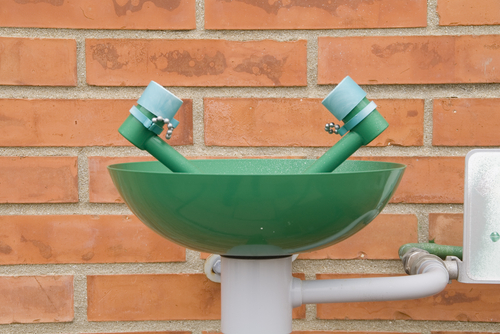When a worker gets hazardous substances in the eyes or on the skin, seconds count. Make sure your workers can get to an eyewash station or safety shower quickly and know how to use it properly.
 |
- A worker mixes chemicals incorrectly, and they explode in his face.
- Another drops a bottle, and the chemical splashes all over her.
- Someone else slips on a wet floor and grabs for a handhold—accidentally dipping his arm into a vat of solvent.
If something goes wrong while employees are working with chemicals and the substance gets in their eyes or on their skin, would they know what to do to save their eyesight or skin and minimize the damage?
To protect their eyes and skin from hazardous materials, employees need to know answers to questions such as the following:
Where are the eyewash and shower? Whenever they work with chemicals, employees should make sure they know where the nearest eyewash and shower are, and that they can get to the eyewash in a matter of seconds if they have to—with their eyes closed! (If a chemical splashes into their eyes, they may not be able to see where they’re going.) For a skin exposure, workers also need to be able to get to the shower in a few seconds. The shower and eyewash may be together, or eyewashes may be located at sinks or in other areas away from safety showers. Employees shouldn’t have to go through a doorway to get to the nearest eyewash or shower, and you should alert supervisors to make sure access to eyewashes and showers are not blocked by materials, equipment, or any other obstructions.
Why a matter of seconds? Some hazardous chemicals take only 6 to 8 seconds to penetrate the outer membrane of your eye to its interior, where they can do the most serious damage. For skin exposures, workers might have as long as 10 to 15 seconds. In either case, employees with skin or eye exposures can’t afford to waste time trying to find the eyewash or shower.
All the safety training you need in one program: 25 subjects, one low price. It’s BLR’s Safety Training Presentations. Try it at no cost. Get the details.
How do I use an eyewash? It’s essential that employees know how to use an eyewash properly so that the water reaches their eyes effectively. Teach workers to follow these steps when using an eyewash:
- Turn it on. Push the handle or otherwise activate the water flow, then let go; the eyewash should stay on until you turn it off.
- Remove contact lenses if you’re wearing them. They trap contaminants in your eyes and prevent the eyewash from washing out the hazardous chemical.
- Hold your eyes open. They’ll want to close, but you have to hold them open and let the water in directly. Uncomfortable as this is, it’s better to suffer the discomfort than to become permanently blind.
- Don’t rub. Rubbing your eyes could force contaminants in deeper or further damage already injured tissue.
- Don’t stop. You need to flush your eyes with water for a full 15 minutes.
- See a doctor. You may need additional medical attention to save your vision.
How do I use a safety shower? After a skin exposure to a hazardous chemical, employees should get to a safety shower and:
- Turn on the shower.
- Undress. This is no time for modesty. Start with your shoes and socks; many people have caused serious burns to their feet and ankles when their shoes and socks trapped hazardous chemicals they were trying to wash
off. Every item of clothing below where the chemical is located must come off. Don’t be shy about letting co-workers help you, either. The sooner the chemical is washed off your skin, the less serious your injury will be. - Don’t rub. Rubbing your skin can drive chemicals deeper or further damage already injured tissue.
- Stay put. Flush your skin for at least 15 minutes or until emergency medical assistance arrives.
Try Safety Training Presentations at no cost and no risk. Find out more.
What if my co-worker is exposed? If a co-worker is exposed to hazardous chemicals, other employees help out by taking these steps:
- Help him or her get to the eyewash or safety shower and turn it on.
- Hold his or her eyes open if needed.
- Help your co-worker remove contaminated clothing if he or she needs assistance.
- Call 911.
- Make sure your co-worker flushes his or her eyes or skin for a full 15 minutes.
- Make a note of which chemical your co-worker was exposed to. If possible, provide the material safety data sheet to emergency medical personnel when they arrive.
- Watch yourself. If you become contaminated, too, be sure to flush your own eyes or skin with water.

Rather than turn on the eyewash you should note that the eyewash needs to be activated (or turned on) by a one hand motion. Not turn on the water and then push the handle.
I am getting very confusing messages regarding eyewash stations.
I have been informned that eyewash stations with a 15 minute flush HAVE TO BE INSTALLED in all chemical storage areas.
In most areas of our facility that would involve construction. The notification I have recieved state that Fedral State and Regulatory guidelines are clear this is a mandate for all facilities and organizations